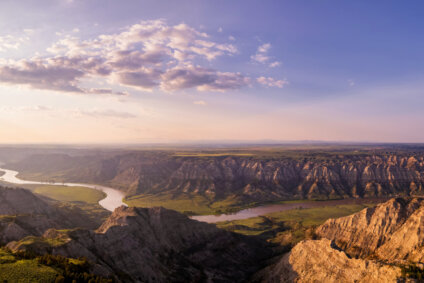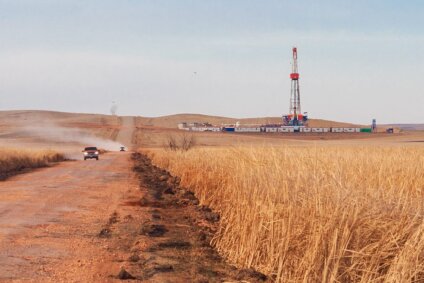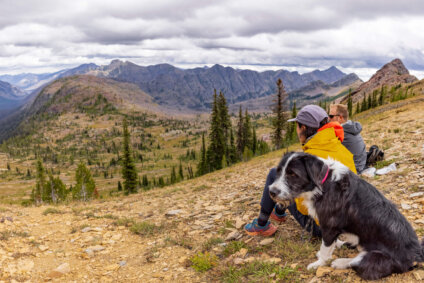Hooked for Life
A trip into the Great Burn proves transformative for one backpacker now devoted to protecting this proposed wilderness area
It’s early September, and I step out of my car and into the sunshine atop Hoodoo Pass, one of the access points of the Stateline Trail on the border of Idaho and Montana. The sun hasn’t been up long enough to remove the frost from the leaves or the chill from the air. I’m warm enough in my down jacket and hiking boots, but when I look to the faces of the ten college freshmen standing in front of me, it’s clear that the experience of being cold on a ridgeline in the early morning is new to many of them. They pull sweatshirt sleeves over their hands and look dubiously at the heavy backpacks sitting on the dusty ground in front of them.
Standing in front of the students I’m about to lead into the proposed Great Burn Wilderness, I offer as much advice as possible. I hand out extra pairs of wool socks, apply bandages to ward off blisters, and engage in some last-minute backpack adjustments. One student wants to leave his rain jacket, but I persuade him to bring it along. Another wonders whether she’s brought too much food. “No way,” reassures her classmate, grabbing her extra package of cookies and tossing it in his own pack. She smiles gratefully at the lightened load.
I can easily remember my first backpacking trip, many years ago. The heaviest thing I carried was my toiletry kit, complete with travel-sized shampoo and conditioner. (Did I think I was going to take a shower at the top of the mountain?) I didn’t like the look of my pack’s hipbelt cinched around my waist, so I chose not to buckle it, instead letting the weight hang from my shoulders. It was only an overnight trip, but I returned home exhausted, sore, and already wiser about backcountry travel.
As the years passed, I found myself backpacking more and more, not only for recreation, but also for employment. I began leading trail crews, wilderness monitoring programs, and backcountry education trips. Shortly after moving to Montana, I became involved with the Great Burn Study Group, which opened my eyes to the incredibly gorgeous backcountry surrounding the Idaho/Montana divide.
The more time I spend in the Great Burn, the more I'm hooked on its unique character. Lush green creek bottoms give way to wildflower-covered high country that gives Glacier a run for its money. Mountain goats perch on cliffs above shining alpine lakes. The view from the Stateline Trail stretches miles in all directions, encompassing dry rocky cliffs, green alpine meadows, humid draws stretching down into cedar groves, and all the vivid colors the Rocky Mountain high country has to offer. It truly is a magical place to spend a day, a week, or a season.
It has now been six years since I spent my first night in the Great Burn. As I stand on Hoodoo Pass with ten students anxiously awaiting their first backpacking experience, I remember my own first trip many years ago and reflect on what I’ve learned since then. I’ve learned that it only takes one good experience to hook someone on Wilderness for life.
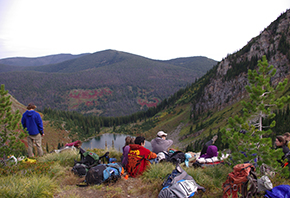
Student backpackers looking out over the Great Burn (photo by Drew Lefebvre).
I’ve also learned that the most transformative experiences often happen where you least expect them. Time and again, students have told me that they had no idea their short time spent in the Great Burn would be so life-changing. They are amazed that such a wild place exists so close to their university, that it is so accessible, and that it isn’t overcrowded.
Many of these students go on to pursue degrees in wildlife or resource management, spend a summer working for the Forest Service, or land an internship with a conservation organization. I’ve helped with a dozen reference checks and written recommendations over the years. I cherish the notes I’ve received saying that former students have continued to spend time in the backcountry, either for work or for recreation, or have revisited the Great Burn for a backpacking trip of their own.
Most importantly, I’ve learned that the places furnishing these transformative experiences need our protection and our help. The Great Burn has provided invaluable education for countless individuals, but it can only continue to do so if we afford it permanent protection. If we are unable to achieve that, then we will lose this incredible place not only as an ecological, biological, and environmental resource, but also as an educational one. As someone who began backpacking years ago only to fall in love with the Great Burn, I urge you to learn about it, get involved in its protection, and come visit! And if you run into a group of college students, be sure to stop and say hello.
– Drew Lefebvre is a teaching naturalist at the Montana Natural History Center
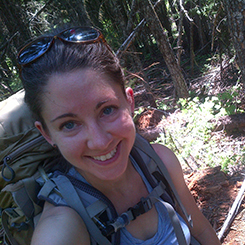
Stay Connected
"(Required)" indicates required fields
